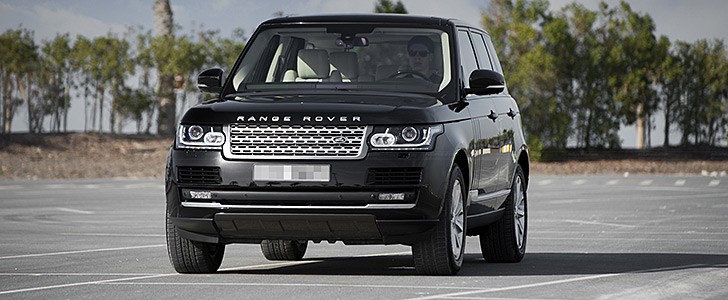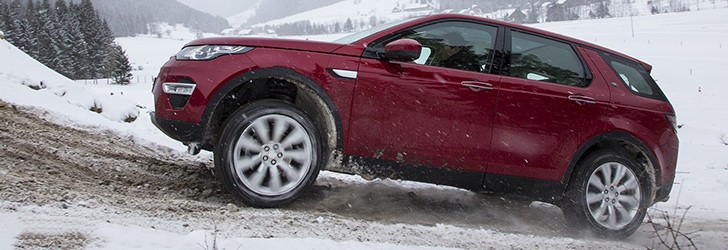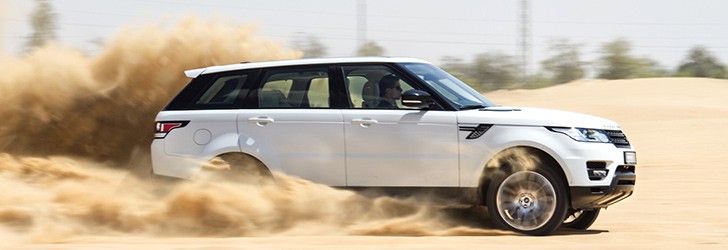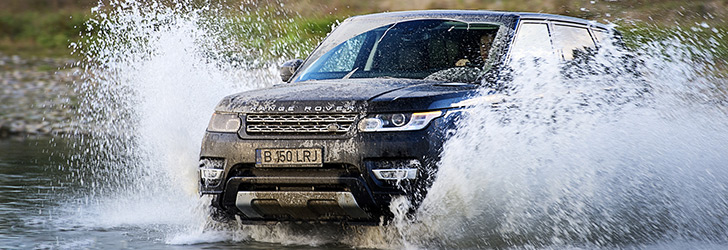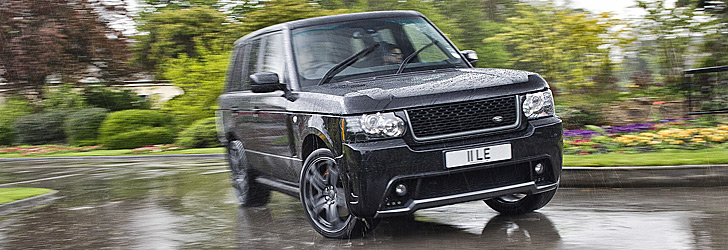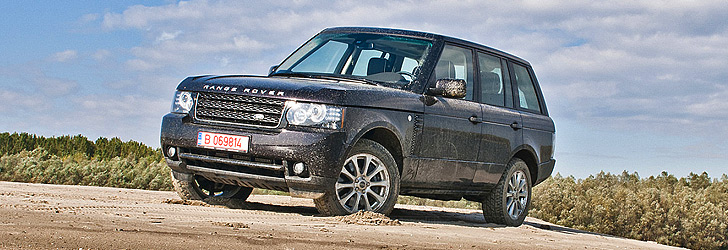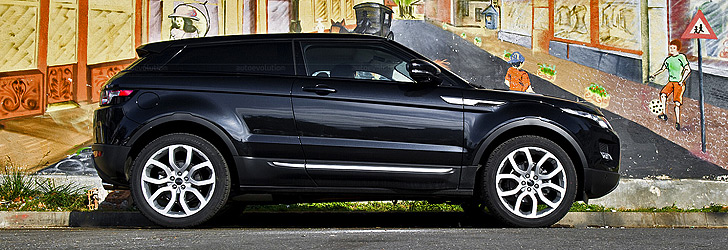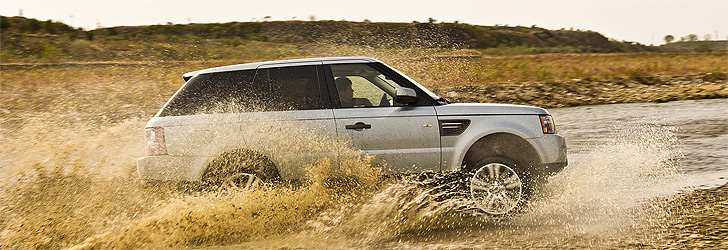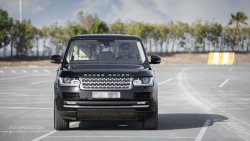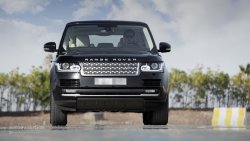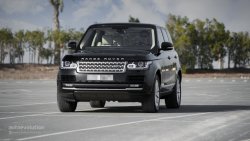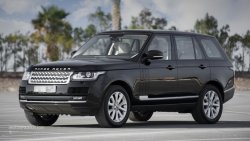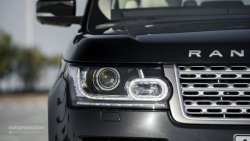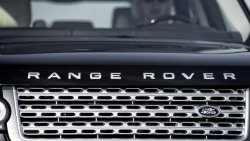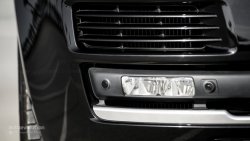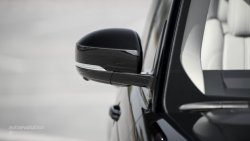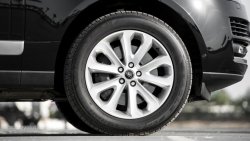Range Rover Supercharged Review
OUR TEST CAR: Range Rover 5.0 Supercharged 2013
The fourth iteration of the Range Rover has stronger ambitions than ever. This generation is no longer an offroader adapted as much as possible for the playground its Terrain Response is most likely to see, the road. This time the SUV was engineered as an asphalt car from the ground up.
Since Land Rover is now under Tata Motors ownership, the Range Rover has also left the BMW roots behind, so it’s a new start on all fronts.
This Range Rover has also opened its trophy cabinet to receive a new one - the world’s first all-aluminium SUV. The rest of the vehicle’s tech side is an evolution of the previous model’s setup, but the exterior and the interior are also fresh as fresh can be.
Nevertheless, the new model has a tremendous burden on its aluminum fenders, as the previous generation registered hefty sales to the last day it was present in showrooms. Nobody cared that an all-new car was coming, the Range Rover brought in one customer after another.
Read the Range Rover’s history book a bit more thoroughly and you’ll notice that, when it comes to status, cars don’t come much sharper than this. Not only does the Range Rover sit alongside the biggest names in the automotive world, but it has gained this aura in half the time it took others to achieve it.
For example, the Bentley Continental GT’s family tree creates a connection with its predecessors that runs back to the 1920s’ Le Mans laurels, whereas the Range Rover came to the world in 1970, built by a company that sought inspiration in the Jeep Willis. Nowadays, you can match a Range Rover with any kind of exotic supercar costing ten times as much and your garage won’t mind.
Since the new Range Rover is aiming to be superior to the model it replaces in every way possible, we decided to asses it at its full potential - we chose the Supercharged model, a perfect synonym for the notion of “powerhouse”.
The blown five-liter V8 under its hood is an extremely popular choice in the Middle East, so we went to drive the vehicle in one of its favorite markets. For us, this meant that we’d get to put its updated electronics to work on the dunes, an environment Range Rovers have long been familiar with.
The presence of a Range Rover is one of the pillars of its DNA, so Land Rover had to make sure that its flagship keeps its proportions and unique appearance. If we had to describe the result in three words, we'd say "they did it". Unfortunately, there are quite a few explanations to be offered here and when all is taken into account, the situation doesn't look so victorious for the Range Rover anymore.
The Range Rover has kept its overall silhouette, but has borrowed certain styling elements from the company's new design language, introduced by the Evoque. The SUV doesn't take too much inspiration from the baby Range Rover though - that approach will be left for the upcoming Range Rover Sport. As for the dimensions, there are only gentle changes, with the most notable being a 1.1 inch (28 mm) increase in length.
The most interesting part of the new styling is the integration of the aerodynamic and styling-only elements into the body. This is the first time when we really see the fancy bits as a part of a Range Rover, not some decorations fitted to a set of boxy shapes.
And it doesn't just work for the eye, as the new design brings the drag coefficient to a decent 0.34. The value, which is 10 better compared to that of the previous model, has been achieved though overall upgrades, including flat underbody protection elements. Another example would be the front grille, which is gifted with active vanes. These improve aerodynamics by blocking the grille off when extra cooling is not needed.
Up front, the traditional grille is mixed with headlights that look like photography hardware and flow towards the side of the car for achieving that aforementioned integration. Zooming out, it becomes obvious that both the face and the windscreen of the SUV are now considerably more raked.
Move to the side and you'll notice that the Range Rover now looks more like the outgoing Range Rover Sport rather than its predecessor. The roof now has true shapes and the glasshouse had ditched the detached look in favor of a visual unification with the lower body.
The profile is also adorned with air vents on the front doors, in order to establish a connection with the previous generation of the Range Rover. These only serve an aesthetic function and they don't really seem to blend in with the rest of the shapes present on the side.
The rear end is perhaps the part of the Range Rover that doesn't manage to keep up with the rest of it when it comes to meeting the eye. We liked what we saw until we reached the "Range Rover" badging on the tailgate. Below, we found a pair of taillights that simply aren't royal enough for a Range Rover.
The same impression was offered by the lowest part of the SUV's rear fascia. The angle and styling used are there to provide offroad capabilities and protection. The Supercharged version gets the same modest-looking exhaust as the rest of the range, so it offers the same rough terrain capabilities. While we approve this kind of principles, we can't help thinking that a little more time spend drawing this part of the car could've made it much better looking without affecting its functional side.
The fourth-generation Range Rover keeps its distinctive looks - a child could spot one in the dusk. However, as daylight appears, you'll notice that the modernization of the design has been done at a cost, a partial downtune in terms of prestige.
From the moment you open the door of the Range Rover, you notice that things have become more efficient, you just feel that the massive structure is now easier to handle.
Climb aboard and you'll observe that the interior had been handed to a Yoga specialist before it was released on the market. The new cabin is much more balanced, it packs all the functions of the previous one in about half the number of the controls.
The word here is "digitization" - the third generation had already started this through its TFT display instrument panel, but now the trend has spread all across the interior. Since we're here, we'll also mention that we'd like the 12.3-inch instrument display to be more configurable.
Designers coupled this new arrangement with the better organization of the buttons and switches, in order to for the cabin to offer the impression of a modern environment. The aforementioned purpose was also the reason for which the massive upright shapes of the previous model's interior were partially tamed. The aforementioned moves have bought a cleaner appearance, while ergonomics stay at a good level - we don't necessarily receive a boost in ergonomics, as the gain achieved by the smoother layout is balanced by the more complex operation required by certain controls
If the exterior of the Range Rover stole a few tricks from the Evoque, the cabin of the SUV takes far greater inspiration in its little cousin's interior styling. The dashboard, sans the instrument panel, as well as the center console, bring a strong resemblance to those in the junior Range Rover.
Speaking of the center console, this is gifted with an eight-inch touchscreen display that's also shared with the Evoque, among other Jaguar Land Rover models. This is flanked by two columns of buttons that look virtual but are actually real. The screen offers interesting capabilities, such as allowing the driver and the passenger to see different things. Unfortunately, you don't need a trained eye to spot the mediocre resolution, which ruins the pleasure.
The driving position is more commanding than ever and there's also a new steering wheel, which groups the controls in an elegant way. What's more, now you can also use the horn in dangerous situations - in the old Range Rover you had to operate this using two vertical strips which didn't always come in handy when you were in an extreme rush.
Moving away from the little elements, we reach the part where we talk about the interior space, which is the biggest gain of the new Range Rover.
The previous model didn't lack cabin room by any standards, but the fourth generation really steps up this game. The biggest changes can be found in the back, where the legroom has been increased by a gargantuan 4.7 inches (119.4 mm). This comes thanks to an 1.65 inch (42 mm) boost in the wheelbase. In addition to that, the doors are now more generously sized and the rear seats are reclining units, so the passengers feel no less than spoiled.
Your luggage is also given a stylish welcome, as the lower side of the tailgate is joins the upper one in electric operation. Before you get too excited about this, we have to mention that the slow descent did make us wish we had the manual system of the previous generation.
In the aforementioned digitization process, the Range Rover's cabin has lost some of its nobility. It's still a luxurious world, but it doesn't use the full potential of its blazon.
The generation change has brought an increase in length for the Range Rover and since this wasn’t the most compact car on Earth, one could expect the new model to be inferior to its predecessor in terms of city driving. Nevertheless, the extra length can easily be neglected thanks to the fact that the Range Rover has been put on a severe diet.
The biggest problem with driving the old model in urban environments was the fact that many of the swift movements required by this kind of traffic made the car uncomfortable. Now the Range Rover feels much lighter on its feet, it’s no longer intimidated by the chaotic and abrupt city driving patterns.
Before you consider tackling city center in a Range Rover, we should explain that in this car parking is still a job that takes time. Land Rover may have added an automated parallel parking system, but the automotive industry hasn’t reached a level that allows this kind of developments to be perfectly usable in the real world - when things get complicated, this aid doesn’t make any difference.
The Range Rover has also gotten quieter and in the city this means that driving it feels like you’ve never left home, such is the level of refinement. As for the frequent stops included in everyday driving, the Range Rover’s improved cabin access makes these easier to manage.
Land Rover’s creation is now more efficient, but this only means that it’s less of a gas guzzler and the city is the area where you’ll be most bothered by this.
You’re getting loads of muscle for all that burned gas though. It’s way more than you need for urban driving. The Supercharged model we drove has ridiculous power resources for the city: if there’s a fly on the accelerator pedal and you squash it, you’ll be traveling at double the speed limit.
The fourth generation of the Range Rover is more capable inside the city compared to the one it replaces. You still have to face the sheer size of the car, which is now even larger, but the overall experience makes sustained efforts to compensate for this.
The Range Rover has spent a considerable amount of time in the sauna in its journey between generations and you can feel this from the first moment you set off.
We have to set one thing straight though: the Range Rover may be considerably thinner, but at 5,137 lbs (2,330 kg), it can't be described as "light", not even in the SUV context.
Regardless of that, the lesser mass means that the V8 under the hood is now... superthrilled, as it can demonstrate its abilities more freely. The 0-60 mph (96 km/h) game is played in 5.1 seconds, 0.8 seconds quicker than before. As for the 0 to 62 mph sprint, this takes 5.4 seconds. You feel the extra freedom of movement comapred to the previous Range Rover, but the overall impression is the same: an effortless blast into the horizon.
The straight line performance is simply absurd if you consider the weight of the car and still impressive even when you don't. You sit in between the veneers and the leather and, as you abuse the throttle, the digital needle travels at an amazing speed.
This car must be schizophrenic, it really isn't aware of a notion we all accept - aerodynamic drag. The Range Rover Supercharged just keeps surging forward until you finally realize you're being childish and let go of the throttle.
As for the stopping part of the deal, the Brembo braking hardware keeps the car well in check, but, if you insist, the fading does arrive. What's more, the pedal travel is long enough to provide a pleasant offroad use.
The aluminum diet of the Range Rover has, of course, also brought fuel efficiency benefits. In the case of the Supercharged model, the figures indicate a nine percent drop in terms of fuel consumption.
The Range Rover Supercharged offered us 12.4 mpg (19 liters per 100 km), while its EPA rating sits at 15 mpg (15.7 liters per 100 km). Land Rover is well aware that the vehicle is still one of the hungriest beasts out there, so it has gifted it with a fuel tank measuring 27.7 gallons (105 liters).
The Range Rover Supercharged may be one of the thirstiest cars on sale, but we have to understand that there are markets where this has limited relevance, such as the Middle East or the US.
We have to explain that the driving experience is entirely different from what the rest of the performance SUVs on the market offer. The Range Rover Supercharged feels closer to a Bentley Continental GT than a to Cayenne GTS or a G63 AMG.
The vehicle is set up in a manner that favors understeer and if you're really in a hurry, you have to learn two things. First of all you must be able to ignore the excruciating tire squeal. In addition, you can tame some of the understeer you encounter by keeping the front axle in check using the brakes, adding more grip to the front wheels. However, driving in this manner would mean that you're missing the point of the Range Rover Supercharged.
This is a car that has loads of power in order to feel noble, not sporty. In this respect, the only thing that accompanies the rising numbers as you accelerate is a well-controlled V8 voice, coming straight from the engine compartment. The power delivery is extremely linear and you can enjoy the full muscle of the engine from 2,000 rpm.
Another aspect that sets the Range Rover Supercharger apart from most performance SUVs is the rather soft suspension. Despite being gifted with adaptive dampers and active stabilizer bars, the vehicle shows generous body roll and the problem becomes even more serious when it comes to the pitch and dive area.
Since this SUV was built for comfortable, all-round driving, you would imagine that it offers a flying carpet-like experience. Unfortunately, it doesn't. The Range Rover's sound proofing, quality cabin and characteristic feeling work together to achieve the aforementioned goal. Alas, their efforts don't bring half the benefits they could due to a really unpleasant interference coming from the suspension.
The Range Rover simply can't handle larger road caprices without sending a quick shock all the way through the seats. You won't feel this too often, but a speed bump is enough to remind you of it - this is an issue that wasn't present on the previous generation. It is a bit more pronounced on the Supercharged model, which comes with a firmer ride, but the problem is spread across the range.
As for the electric power-assisted steering, this does offer a useful assistance modulation, but is extremely introvert. Such a car wouldn't have needed a sporty steering, but a few traces of feedback would've made things much better.
Considering all these aspects, the best way to use the Range Rover Supercharged is to feed it with great distances. Out on the open road there are less chances of encountering hefty bumps or potholes, while the vehicle's level of comfort and resources will serve you well.
Ask a Range Rover about its favorite song and it will say "These Boots Are Made for Walkin'" - it is time to talk about the offroading abilities of the new flagship Land Rover.
The previous model was extremely capable at keeping you well isolated from the violent process of devouring any terrain you placed under its wheels. Thus, there was no need for significant technological upgrades when it came to this field, but the engineers updated the SUV for the fun of it.
The suspension now offers more wheel travel, while the new styling cues have lead to improved approach and departure angles. The wading depth was boosted by 7.8 inches (198 mm) to 35.4 inches (899 mm). This asset comes thanks to the rerouting of the air intake, which now has the opening placed just above the front wheel arches.
As for the ground clearance, the air suspension offers two off-road levels of extra height, eventually reaching 11.9 inches (302 mm). The first level, which sits 1.35 inches (34 mm)lower than the aforementioned value, can now be used up to 50 mph (80 km/h). - previously the Range Rover only allowed the driver to use the off-road suspension setting up to 31 mph (50 km/h).
In addition to that, the Range Rover's trademark Terrain Response system is now present in its second version. First of all, you'll find the usual settings, which include General, Grass/Gravel/Snow, Mud/Ruts, Sand and Rock Crawl. The second incarnation of the system plays the automatization card, offering Auto setting that sorts everything out for you.
Despite the fact that the old Range Rover was already very good for offroad driving, it's not difficult to spot the benefits brought by the aforementioned changes. You now have superior control, but the car's size can still be felt.
Alas, spotting them is one thing and being able to put them to good use is another one, a rather... impossible one. That's because the aforementioned bumpy ride issue obviously also shows its face on rough terrain. You get the feeling of a little crash each time you attack a harder element of the land. Thus, you are discouraged from using the Range Rover's abilities.
The Range Rover is one of the most technology-packed vehicles on sale today, but it comes with multiple implementation issues that manage to keep if from shining. What's more, this problem can be felt both on and off the road.
Since Land Rover is now under Tata Motors ownership, the Range Rover has also left the BMW roots behind, so it’s a new start on all fronts.
This Range Rover has also opened its trophy cabinet to receive a new one - the world’s first all-aluminium SUV. The rest of the vehicle’s tech side is an evolution of the previous model’s setup, but the exterior and the interior are also fresh as fresh can be.
Nevertheless, the new model has a tremendous burden on its aluminum fenders, as the previous generation registered hefty sales to the last day it was present in showrooms. Nobody cared that an all-new car was coming, the Range Rover brought in one customer after another.
Read the Range Rover’s history book a bit more thoroughly and you’ll notice that, when it comes to status, cars don’t come much sharper than this. Not only does the Range Rover sit alongside the biggest names in the automotive world, but it has gained this aura in half the time it took others to achieve it.
For example, the Bentley Continental GT’s family tree creates a connection with its predecessors that runs back to the 1920s’ Le Mans laurels, whereas the Range Rover came to the world in 1970, built by a company that sought inspiration in the Jeep Willis. Nowadays, you can match a Range Rover with any kind of exotic supercar costing ten times as much and your garage won’t mind.
Since the new Range Rover is aiming to be superior to the model it replaces in every way possible, we decided to asses it at its full potential - we chose the Supercharged model, a perfect synonym for the notion of “powerhouse”.
The blown five-liter V8 under its hood is an extremely popular choice in the Middle East, so we went to drive the vehicle in one of its favorite markets. For us, this meant that we’d get to put its updated electronics to work on the dunes, an environment Range Rovers have long been familiar with.
The presence of a Range Rover is one of the pillars of its DNA, so Land Rover had to make sure that its flagship keeps its proportions and unique appearance. If we had to describe the result in three words, we'd say "they did it". Unfortunately, there are quite a few explanations to be offered here and when all is taken into account, the situation doesn't look so victorious for the Range Rover anymore.
The Range Rover has kept its overall silhouette, but has borrowed certain styling elements from the company's new design language, introduced by the Evoque. The SUV doesn't take too much inspiration from the baby Range Rover though - that approach will be left for the upcoming Range Rover Sport. As for the dimensions, there are only gentle changes, with the most notable being a 1.1 inch (28 mm) increase in length.
The most interesting part of the new styling is the integration of the aerodynamic and styling-only elements into the body. This is the first time when we really see the fancy bits as a part of a Range Rover, not some decorations fitted to a set of boxy shapes.
And it doesn't just work for the eye, as the new design brings the drag coefficient to a decent 0.34. The value, which is 10 better compared to that of the previous model, has been achieved though overall upgrades, including flat underbody protection elements. Another example would be the front grille, which is gifted with active vanes. These improve aerodynamics by blocking the grille off when extra cooling is not needed.
Up front, the traditional grille is mixed with headlights that look like photography hardware and flow towards the side of the car for achieving that aforementioned integration. Zooming out, it becomes obvious that both the face and the windscreen of the SUV are now considerably more raked.
Move to the side and you'll notice that the Range Rover now looks more like the outgoing Range Rover Sport rather than its predecessor. The roof now has true shapes and the glasshouse had ditched the detached look in favor of a visual unification with the lower body.
The profile is also adorned with air vents on the front doors, in order to establish a connection with the previous generation of the Range Rover. These only serve an aesthetic function and they don't really seem to blend in with the rest of the shapes present on the side.
The rear end is perhaps the part of the Range Rover that doesn't manage to keep up with the rest of it when it comes to meeting the eye. We liked what we saw until we reached the "Range Rover" badging on the tailgate. Below, we found a pair of taillights that simply aren't royal enough for a Range Rover.
The same impression was offered by the lowest part of the SUV's rear fascia. The angle and styling used are there to provide offroad capabilities and protection. The Supercharged version gets the same modest-looking exhaust as the rest of the range, so it offers the same rough terrain capabilities. While we approve this kind of principles, we can't help thinking that a little more time spend drawing this part of the car could've made it much better looking without affecting its functional side.
The fourth-generation Range Rover keeps its distinctive looks - a child could spot one in the dusk. However, as daylight appears, you'll notice that the modernization of the design has been done at a cost, a partial downtune in terms of prestige.
From the moment you open the door of the Range Rover, you notice that things have become more efficient, you just feel that the massive structure is now easier to handle.
Climb aboard and you'll observe that the interior had been handed to a Yoga specialist before it was released on the market. The new cabin is much more balanced, it packs all the functions of the previous one in about half the number of the controls.
The word here is "digitization" - the third generation had already started this through its TFT display instrument panel, but now the trend has spread all across the interior. Since we're here, we'll also mention that we'd like the 12.3-inch instrument display to be more configurable.
Designers coupled this new arrangement with the better organization of the buttons and switches, in order to for the cabin to offer the impression of a modern environment. The aforementioned purpose was also the reason for which the massive upright shapes of the previous model's interior were partially tamed. The aforementioned moves have bought a cleaner appearance, while ergonomics stay at a good level - we don't necessarily receive a boost in ergonomics, as the gain achieved by the smoother layout is balanced by the more complex operation required by certain controls
If the exterior of the Range Rover stole a few tricks from the Evoque, the cabin of the SUV takes far greater inspiration in its little cousin's interior styling. The dashboard, sans the instrument panel, as well as the center console, bring a strong resemblance to those in the junior Range Rover.
Speaking of the center console, this is gifted with an eight-inch touchscreen display that's also shared with the Evoque, among other Jaguar Land Rover models. This is flanked by two columns of buttons that look virtual but are actually real. The screen offers interesting capabilities, such as allowing the driver and the passenger to see different things. Unfortunately, you don't need a trained eye to spot the mediocre resolution, which ruins the pleasure.
The driving position is more commanding than ever and there's also a new steering wheel, which groups the controls in an elegant way. What's more, now you can also use the horn in dangerous situations - in the old Range Rover you had to operate this using two vertical strips which didn't always come in handy when you were in an extreme rush.
Moving away from the little elements, we reach the part where we talk about the interior space, which is the biggest gain of the new Range Rover.
The previous model didn't lack cabin room by any standards, but the fourth generation really steps up this game. The biggest changes can be found in the back, where the legroom has been increased by a gargantuan 4.7 inches (119.4 mm). This comes thanks to an 1.65 inch (42 mm) boost in the wheelbase. In addition to that, the doors are now more generously sized and the rear seats are reclining units, so the passengers feel no less than spoiled.
Your luggage is also given a stylish welcome, as the lower side of the tailgate is joins the upper one in electric operation. Before you get too excited about this, we have to mention that the slow descent did make us wish we had the manual system of the previous generation.
In the aforementioned digitization process, the Range Rover's cabin has lost some of its nobility. It's still a luxurious world, but it doesn't use the full potential of its blazon.
The generation change has brought an increase in length for the Range Rover and since this wasn’t the most compact car on Earth, one could expect the new model to be inferior to its predecessor in terms of city driving. Nevertheless, the extra length can easily be neglected thanks to the fact that the Range Rover has been put on a severe diet.
The biggest problem with driving the old model in urban environments was the fact that many of the swift movements required by this kind of traffic made the car uncomfortable. Now the Range Rover feels much lighter on its feet, it’s no longer intimidated by the chaotic and abrupt city driving patterns.
Before you consider tackling city center in a Range Rover, we should explain that in this car parking is still a job that takes time. Land Rover may have added an automated parallel parking system, but the automotive industry hasn’t reached a level that allows this kind of developments to be perfectly usable in the real world - when things get complicated, this aid doesn’t make any difference.
The Range Rover has also gotten quieter and in the city this means that driving it feels like you’ve never left home, such is the level of refinement. As for the frequent stops included in everyday driving, the Range Rover’s improved cabin access makes these easier to manage.
Land Rover’s creation is now more efficient, but this only means that it’s less of a gas guzzler and the city is the area where you’ll be most bothered by this.
You’re getting loads of muscle for all that burned gas though. It’s way more than you need for urban driving. The Supercharged model we drove has ridiculous power resources for the city: if there’s a fly on the accelerator pedal and you squash it, you’ll be traveling at double the speed limit.
The fourth generation of the Range Rover is more capable inside the city compared to the one it replaces. You still have to face the sheer size of the car, which is now even larger, but the overall experience makes sustained efforts to compensate for this.
The Range Rover has spent a considerable amount of time in the sauna in its journey between generations and you can feel this from the first moment you set off.
We have to set one thing straight though: the Range Rover may be considerably thinner, but at 5,137 lbs (2,330 kg), it can't be described as "light", not even in the SUV context.
Regardless of that, the lesser mass means that the V8 under the hood is now... superthrilled, as it can demonstrate its abilities more freely. The 0-60 mph (96 km/h) game is played in 5.1 seconds, 0.8 seconds quicker than before. As for the 0 to 62 mph sprint, this takes 5.4 seconds. You feel the extra freedom of movement comapred to the previous Range Rover, but the overall impression is the same: an effortless blast into the horizon.
The straight line performance is simply absurd if you consider the weight of the car and still impressive even when you don't. You sit in between the veneers and the leather and, as you abuse the throttle, the digital needle travels at an amazing speed.
This car must be schizophrenic, it really isn't aware of a notion we all accept - aerodynamic drag. The Range Rover Supercharged just keeps surging forward until you finally realize you're being childish and let go of the throttle.
As for the stopping part of the deal, the Brembo braking hardware keeps the car well in check, but, if you insist, the fading does arrive. What's more, the pedal travel is long enough to provide a pleasant offroad use.
The aluminum diet of the Range Rover has, of course, also brought fuel efficiency benefits. In the case of the Supercharged model, the figures indicate a nine percent drop in terms of fuel consumption.
The Range Rover Supercharged offered us 12.4 mpg (19 liters per 100 km), while its EPA rating sits at 15 mpg (15.7 liters per 100 km). Land Rover is well aware that the vehicle is still one of the hungriest beasts out there, so it has gifted it with a fuel tank measuring 27.7 gallons (105 liters).
The Range Rover Supercharged may be one of the thirstiest cars on sale, but we have to understand that there are markets where this has limited relevance, such as the Middle East or the US.
We have to explain that the driving experience is entirely different from what the rest of the performance SUVs on the market offer. The Range Rover Supercharged feels closer to a Bentley Continental GT than a to Cayenne GTS or a G63 AMG.
The vehicle is set up in a manner that favors understeer and if you're really in a hurry, you have to learn two things. First of all you must be able to ignore the excruciating tire squeal. In addition, you can tame some of the understeer you encounter by keeping the front axle in check using the brakes, adding more grip to the front wheels. However, driving in this manner would mean that you're missing the point of the Range Rover Supercharged.
This is a car that has loads of power in order to feel noble, not sporty. In this respect, the only thing that accompanies the rising numbers as you accelerate is a well-controlled V8 voice, coming straight from the engine compartment. The power delivery is extremely linear and you can enjoy the full muscle of the engine from 2,000 rpm.
Another aspect that sets the Range Rover Supercharger apart from most performance SUVs is the rather soft suspension. Despite being gifted with adaptive dampers and active stabilizer bars, the vehicle shows generous body roll and the problem becomes even more serious when it comes to the pitch and dive area.
Since this SUV was built for comfortable, all-round driving, you would imagine that it offers a flying carpet-like experience. Unfortunately, it doesn't. The Range Rover's sound proofing, quality cabin and characteristic feeling work together to achieve the aforementioned goal. Alas, their efforts don't bring half the benefits they could due to a really unpleasant interference coming from the suspension.
The Range Rover simply can't handle larger road caprices without sending a quick shock all the way through the seats. You won't feel this too often, but a speed bump is enough to remind you of it - this is an issue that wasn't present on the previous generation. It is a bit more pronounced on the Supercharged model, which comes with a firmer ride, but the problem is spread across the range.
As for the electric power-assisted steering, this does offer a useful assistance modulation, but is extremely introvert. Such a car wouldn't have needed a sporty steering, but a few traces of feedback would've made things much better.
Considering all these aspects, the best way to use the Range Rover Supercharged is to feed it with great distances. Out on the open road there are less chances of encountering hefty bumps or potholes, while the vehicle's level of comfort and resources will serve you well.
Ask a Range Rover about its favorite song and it will say "These Boots Are Made for Walkin'" - it is time to talk about the offroading abilities of the new flagship Land Rover.
The previous model was extremely capable at keeping you well isolated from the violent process of devouring any terrain you placed under its wheels. Thus, there was no need for significant technological upgrades when it came to this field, but the engineers updated the SUV for the fun of it.
The suspension now offers more wheel travel, while the new styling cues have lead to improved approach and departure angles. The wading depth was boosted by 7.8 inches (198 mm) to 35.4 inches (899 mm). This asset comes thanks to the rerouting of the air intake, which now has the opening placed just above the front wheel arches.
As for the ground clearance, the air suspension offers two off-road levels of extra height, eventually reaching 11.9 inches (302 mm). The first level, which sits 1.35 inches (34 mm)lower than the aforementioned value, can now be used up to 50 mph (80 km/h). - previously the Range Rover only allowed the driver to use the off-road suspension setting up to 31 mph (50 km/h).
In addition to that, the Range Rover's trademark Terrain Response system is now present in its second version. First of all, you'll find the usual settings, which include General, Grass/Gravel/Snow, Mud/Ruts, Sand and Rock Crawl. The second incarnation of the system plays the automatization card, offering Auto setting that sorts everything out for you.
Despite the fact that the old Range Rover was already very good for offroad driving, it's not difficult to spot the benefits brought by the aforementioned changes. You now have superior control, but the car's size can still be felt.
Alas, spotting them is one thing and being able to put them to good use is another one, a rather... impossible one. That's because the aforementioned bumpy ride issue obviously also shows its face on rough terrain. You get the feeling of a little crash each time you attack a harder element of the land. Thus, you are discouraged from using the Range Rover's abilities.
The Range Rover is one of the most technology-packed vehicles on sale today, but it comes with multiple implementation issues that manage to keep if from shining. What's more, this problem can be felt both on and off the road.
12
Our LAND ROVER Testdrives:
Photo gallery (82)
